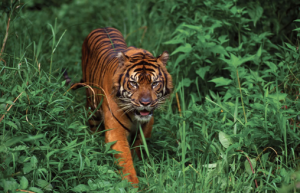
1. The Red Deer
Red deer have had continuous presence in Greece as early as the prehistoric ages. Τo this day the deer live in the mountainous regions of the country. The deer are 1.75 to 2.00m long (male) and 1.60 to 2.10m long (female). In terms of height they are 95 to 150cm tall to their shoulders. Male deer weigh up to 240kg while females weigh up to 170kg. Their horns expand from 71cm up to 150cm (both genders). In Greece the red deer is considered as an endangered species mainly due to illegal hunting activities.
By the end of the 20th century, deer had been confined to the peninsula of Sithonia, the mountains of Rodopi and Parnitha. Today, the Sithonia population is extinct. The protected population of Parnitha seems to be the most robust in the country. Small numbers of deer are kept in breeding farms, and there is a chance that a few animals still exist in the Raftanei-Pramanta region in Epirus from an earlier enrichment.
Poaching is the greatest threat to deer in Greece. Nowadays, the remaining populations are isolated patches. The possibility of deer expansion to new areas is curtailed by the loss of adequate habitats as a result of intensified agriculture, settlement expansion and disturbance.
In order to protect the Red Deer we have to take responsibility up on our shoulders by raising money to fund animal activist organizations. This way they can provide themselves with better equipment. Another possible solution is to push for heavier laws and stronger protection against illegal hunters. And at last but not least the most obvious way we could provide help is by joining such organizations and dedicate our free time by trying to protect the deer by all means possible.
ΠΑΝΑΓΙΩΤΗΣ ΖΟΥΓΑΝΕΛΗΣ
2. The Tiger of Sumatra
The tiger is one of the most imposing animals on the planet. They are among the most endangered: 90% of the world’s tiger population was lost during the 20th century. In particular, the Sumatran Τiger does not exceed 400 to 500 individuals today, while every year at least fifty tigers are killed for the trade in its fur! According to a WWF report, 253 tigers died in traps between 1998-2002, while its habitat decreased from 130,000 to 42,000 sq.km. Historically, tigers have been hunted on a large scale for their sheer beauty. The trade in tiger skins peaked in the 1960s, shortly before international efforts to conserve the species took effect. In 1977, a tiger skin in an English market was worth about $4,250.
Additionally, all trade in tiger parts is illegal under the Convention on International Trade in Endangered Species of Wild Fauna and Flora, and a trade ban has been in place in China since 1993. However, trade in parts in Asia has a major black market industry and government efforts to stop it have so far been ineffective. Almost all of the black market is based in China, and products are sold within the country or shipped to Taiwan, South Korea and Japan. The South China Τiger was nearly extinct due to this trade from the 1950s to the 1970s. Contributing to the illegal trade, there are some illegal farms in the country that specialize in breeding tigers for profit.
ΜΑΡΙΑ ΒΑΪΟΥ
10 ANIMALS THAT ARE CLOSE TO GOING EXTINCT





Ας προστατέψουμε τα ζώα από το πιο άγριο θηρίο που υπάρχει στη Γη, τον «άνθρωπο»…